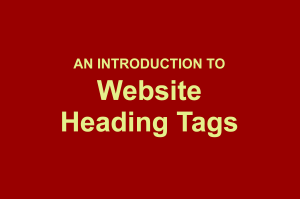What is a Heading Tag?

Technically, heading tags (some people also called these header tags) are HTML elements. (HTML is the language used to render a website.) We use HTML to describe the structure of a web page by tagging different pieces of information. For example, with HTML we can indicate “This is a heading,” “This is a paragraph,” “This is a button.”
Why are heading tags important?
Heading tags indicate to search engines what the page is about. They are also important because they tell a browser how to style a piece of text on a webpage. Finally, they help readers understand your content.
Their importance in search engine optimization
Search engine optimization (SEO) is the practice of making the content of a website easy for search engines to understand and index. One of the many things a search engine looks at when indexing your website are heading tags. Search engines use web crawlers to read web pages and the crawlers index the information that they collect. Tags indicate which information is the most important.
Their importance to a browser
They are important because they tell a browser how to style a piece of text on a webpage.
The effect they have on readability
No one is going to read every single word on every single page of your website. In fact, most people will skim the headings, maybe the beginnings of paragraphs, before settling in to read a page. To a human reader, a page with no structure can look overwhelming.
Headings and other structural elements, such as bullet points and pull quotes, break up the text. While you may have spent hours crafting the most informative article, if readability is poor, if there are too many large areas of text with no variation in font weight or size, many people may not bother reading it. That’s why a page with these structural elements is more readable.
Heading tags provide structure to content
Heading tags follow a hierarchy and are ranked in order of importance from H1-H6. H1 is typically the title of the page and carries the most weight.
Let’s look at the headings in this blog post, the one that you’re reading.
If I were to build an outline based on the content of this page it might look like this:
Title: An Introduction
A. What is a heading tag?
B. Why are heading tags important?
a. Search engine optimization
b. Browsers
c. Readability
d. Structure
C. Conclusion
- In the illustration above, the title: An Introduction to Website Heading Tags is the H1.
- The items labeled with a capital letter are the H2s.
- The lines labeled with a lower case letter are H3s.
How important is it, really, that my website have properly structured heading tags?
Whether you are optimizing your content for the human user experience or for search engine ranking, heading tags are a critical component. They help structure your content, improve readability, accessibility and SEO performance. This article is an introduction to the subject. For a more comprehensive article about this subject, we recommend the Yoast article How to use headings on your site.
To learn more about our website development and search engine optimization services, call (518) 392-0846 or email [email protected].
